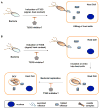Small molecules aimed at type III secretion systems to inhibit bacterial virulence
- PMID: 23930198
- PMCID: PMC3733274
- DOI: 10.1039/C2MD20213A
Small molecules aimed at type III secretion systems to inhibit bacterial virulence
Figures


Similar articles
-
Detection of type III secretion genes as a general indicator of bacterial virulence.Mol Cell Probes. 2003 Feb;17(1):25-32. doi: 10.1016/s0890-8508(02)00108-1. Mol Cell Probes. 2003. PMID: 12628591
-
Chemical Targeting and Manipulation of Type III Secretion in the Phytopathogen Xanthomonas campestris for Control of Disease.Appl Environ Microbiol. 2020 Jan 21;86(3):e02349-19. doi: 10.1128/AEM.02349-19. Print 2020 Jan 21. Appl Environ Microbiol. 2020. PMID: 31732574 Free PMC article.
-
Targeting bacterial virulence: inhibitors of type III secretion in Yersinia.Chem Biol. 2003 Mar;10(3):241-9. doi: 10.1016/s1074-5521(03)00046-2. Chem Biol. 2003. PMID: 12670538
-
Molecular mechanisms of bacterial virulence: type III secretion and pathogenicity islands.Emerg Infect Dis. 1996 Oct-Dec;2(4):270-88. doi: 10.3201/eid0204.960403. Emerg Infect Dis. 1996. PMID: 8969244 Free PMC article. Review.
-
The bacterial injection kit: type III secretion systems.Ann Med. 2005;37(4):234-49. doi: 10.1080/07853890510037329. Ann Med. 2005. PMID: 16019722 Review.
Cited by
-
Epigallocatechin-3-gallate inhibits bacterial virulence and invasion of host cells.Bioorg Med Chem. 2017 Jun 1;25(11):2883-2887. doi: 10.1016/j.bmc.2017.03.023. Epub 2017 Mar 10. Bioorg Med Chem. 2017. PMID: 28325635 Free PMC article.
-
Yunnan Baiyao reduces hospital-acquired pressure ulcers via suppressing virulence gene expression and biofilm formation of Staphylococcus aureus.Int J Med Sci. 2019 Jul 21;16(8):1078-1088. doi: 10.7150/ijms.33723. eCollection 2019. Int J Med Sci. 2019. PMID: 31523169 Free PMC article. Clinical Trial.
-
Small-Molecule Inhibitors of the Type III Secretion System.Molecules. 2015 Sep 23;20(9):17659-74. doi: 10.3390/molecules200917659. Molecules. 2015. PMID: 26404233 Free PMC article. Review.
-
Fluorescence Detection of Type III Secretion Using a Glu-CyFur Reporter System in Citrobacter rodentium.Microorganisms. 2020 Dec 9;8(12):1953. doi: 10.3390/microorganisms8121953. Microorganisms. 2020. PMID: 33316970 Free PMC article.
-
Identification of Novel Type Three Secretion System (T3SS) Inhibitors by Computational Methods and Anti-Salmonella Evaluations.Front Pharmacol. 2021 Nov 16;12:764191. doi: 10.3389/fphar.2021.764191. eCollection 2021. Front Pharmacol. 2021. PMID: 34867388 Free PMC article.
References
-
- Rasko DA, Sperandio V. Nat Rev Drug Discov. 2010;9:117–128. - PubMed
-
- Clatworthy AE, Pierson E, Hung DT. Nat Chem Biol. 2007;3:541–548. - PubMed
-
- Willing BP, Russell SL, Finlay BB. Nat Rev Microbiol. 2011;9:233–243. - PubMed
-
- Keyser P, Elofsson M, Rosell S, Wolf-Watz H. J Intern Med. 2008;264:17–29. - PubMed
Grants and funding
LinkOut - more resources
Full Text Sources
Other Literature Sources

